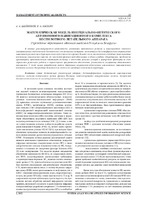| dc.contributor.author | Шейников, А. А. | |
| dc.contributor.author | Малкин, В. А. | |
| dc.coverage.spatial | Минск | ru |
| dc.date.accessioned | 2022-06-28T11:50:08Z | |
| dc.date.available | 2022-06-28T11:50:08Z | |
| dc.date.issued | 2022 | |
| dc.identifier.citation | Шейников, А. А. Математическая модель инерциально-оптического автономного навигационного комплекса беспилотного летательного аппарата = Mathematical model of inertial-optical autonomous navigation complex of unmanned aerial vehicle / А. А. Шейников, В. А. Малкин // Системный анализ и прикладная информатика. – 2022. – № 2. – С. 27-33. | ru |
| dc.identifier.uri | https://rep.bntu.by/handle/data/113377 | |
| dc.description.abstract | В статье рассматривается возможность реализации автономного режима в навигационном комплексе малоразмерного тактического беспилотного летательного аппарата, включающего бесплатформенную инерциальную навигационную систему и бортовую систему технического зрения. В связи с тем, что точность подобных навигационных комплексов существенно зависит от изменений фоноцелевой обстановки и сбоев в работе оборудования, предложено организовать автоматическую адаптацию системы к изменению внешних условий и внутренних факторов за счет управления режимами работы и параметрами программного обеспечения, реализующего алгоритмы оптимального оценивания. С этой целью разработана модель бортового инерциально-оптического автономного навигационного комплекса в классе дискретных динамических систем со случайным изменением структуры. | ru |
| dc.language.iso | ru | ru |
| dc.publisher | БНТУ | ru |
| dc.title | Математическая модель инерциально-оптического автономного навигационного комплекса беспилотного летательного аппарата | ru |
| dc.title.alternative | Mathematical model of inertial-optical autonomous navigation complex of unmanned aerial vehicle | ru |
| dc.type | Article | ru |
| dc.identifier.doi | 10.21122/2309-4923-2022-2-27-33 | |
| local.description.annotation | In the article considers the possibility of implementing an autonomous mode in the navigation complex of a small-sized tactical unmanned aerial vehicle, including a strapdown inertial navigation system and an onboard vision system. Due to the fact that the accuracy of such navigation systems significantly depends on changes in the background-target environment and equipment failures, it is proposed to organize automatic adaptation of the system to changes in external conditions and internal factors by controlling the operating modes and parameters of the software that implements optimal estimation algorithms. For this purpose, a model of an onboard inertial-optical autonomous navigation system has been developed in the class of discrete dynamic systems with a random change in structure. | ru |

